Mauryan Art and Architecture are among the most important topics for the UPSC IAS exam. It covers a significant part of Ancient Indian Art and Architecture in the General Studies Paper 1 syllabus and events in the UPSC Prelims General Studies Paper 1 syllabus.
Introduction
Mauryan art is an art created between the 4th and 2nd Century BC under the Mauryan Empire, which was the first empire to control much of the Indian subcontinent. It marked a significant shiŌ in Indian art from the use of wood to stone. It was a royal art that Mauryan rulers, parƟcularly Ashoka, supported.
- The Great Mauryan ruler Ashoka embraced Buddhism (as a part of shraman tradition) and the immense Buddhist missionary activities that followed during his rule paved the way for the development of Mauryan sculptural and architectural styles.
- Religions of the Shramana tradition, i.e., Jainism and Buddhism emerged around the 6th century BCE.
- King Ashoka patronized the shraman tradition in the third century BCE.
- The shraman tradition refers to several Indian religious movements parallel to but separate from the historical vedic religion.
- It includes Jainism, Buddhism, and others such as Ajivikas, and Carvakas. At this time there were many modes of religious practices including the worship of Yakshas and mother-goddesses. Nevertheless, Buddhism became the most popular.
Background
- In 321 BC, Chandragupta Maurya, with the help of Chanakya (author of Arthashasthra) founded the Mauryan dynasty after overthrowing Nanda Dynasty.
- After the Harappan civilization, monumental stone sculpture and architecture appears only in the Mauryan period.
- The dynasty lasted from 322 BCE to 185 BCE.
- During the Mauryan rule, a new phase of cultural history emerged.
- Monumental stone sculpture and architecture became prominent. This made an important period in Indian cultural history.
- Art and Architecture of Mauryan Empire was characterized by the construcƟon of pillars, sculptures, buildings like stupas, caverns, viharas and chaityas. They are exquisite in aesthetic quality and brilliant in their design and execution.
- The pillars were made of sandstone. It was one of the signature features of Mauryan Art and architecture. They were created as memorials and featured inscripƟons of Emperor Ashoka's edicts.
- Caves were used for meditaƟon and worship having intricate carvings and sculptures adorning their interiors.
- The stupas were large dome-shaped structures used as Buddhist shrines or religious structures.
- The viharas were residenƟal buildings for Buddhist monks.
- Mauryan art was predominantly represented through sculpture.
- The period is noted for the development of the art of stone carving.
- Palaces were grand structures that were home to the king and the royal family. They often had gardens and courtyards.
Expansion of Mauryan Empire
- The Mauryan Empire was the first most powerful Indian empire to bring the entire Indian subcontinent under a single rule.
- The Mauryan empire under Chandragupta Maurya spread its boundaries into Central Asia and Persia.
- Chandragupta Maurya was succeeded by his son Bindusara in 298 BC who expanded the kingdom over most of present-day India, except Kalinga.
Mauryan Dynasty under Ashoka
- Bindusara's kingdom was inherited by his son Ashoka the Great in 274 B.C.
- Under the reign of Ashoka, art and architecture reached their zenith.
Kalinga Invasion
- During the invasion of Kalinga, Ashoka renounced bloodshed and adopted the policy of Ahimsa and adopted Buddhism.
- The adoption of Buddhism by Ashoka promoted the creation of distinctive sculptural and architectural styles.
- These artistic and architectural works were connected to the lives, activities, and patronage of ordinary people.
- Potters played an important role during the Mauryan period. They created various types of pottery, including terracotta figurines and utensils.
- The period was a time of great artistic and architectural achievement.
- There was a focus on Buddhist themes and the patronage of ordinary people.
Classification of Mauryan Art and Architecture :
Mauryan architecture can be divided into Court Art and Popular Art.

Part I : Mauryan Court Art which implies architectural works (in the form of pillars, stupas and palaces.
Palaces: The palaces of the Mauryan period were adorned with gilded pillars. These pillars featured golden vines and silver birds. The palaces were surrounded by high walls with battlements, water ditches, and lotus and plant adornments.
- Greek historian, Megasthenes, described the palaces of the Mauryan empire as one of the greatest creations of mankind and Chinese traveler Fa Hien called Mauryan palaces as god gifted monuments.
- Persian Influence: The Mauryan palaces drew heavy influence from Persian architecture. Specifically, they were inspired by the Achaemenid palaces in Persepolis. Palace of Chandragupta Maurya was inspired by the Achaemenid palaces at Persepolis in Iran.
- Material Used: Wood was the principal building material used during the Mauryan Empire.
- Examples: The Mauryan capital at Pataliputra, Ashoka’s palace at Kumrahar, Chandragupta Maurya’s palace.
Coins:

- The Mauryans minted largely silver and a few copper coins in a variety of forms, sizes, and weights, each with one or more symbols punched on them.
- The elephant, the tree in the fence sign, and the mountain are the most popular emblems.
- The metal was cut first, then the device was punched, which was the standard method of making such coins.
Pillars: Ashokan pillars, (usually made of chunar sandstone), as a symbol of the state, assumed a great significance in the entire Mauryan Empire.
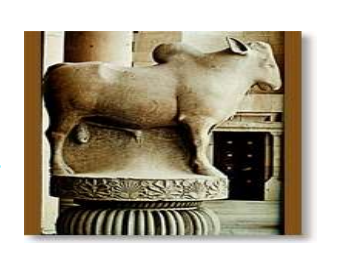
- Objective: The main objective was to disseminate the Buddhist ideology and court orders in the entire Mauryan empire.
- Language: While most Ashoka pillar edicts were in Pali and Prakrit language, few were written in Greek or Aramaic language also.
- Architecture: Mauryan pillars mainly comprise of four parts:
- Shaft: A long shaft formed the base and was made up of a single piece of stone or monolith.
- Capital: On top of shaft lay the capital, which was either lotusshaped or bell-shaped.
- Abacus: Above the capital, there was a circular or rectangular base known as the abacus.
- Capital Figure: All the capital figures (usually animals like a bull, lion, elephant, etc) are vigorous and carved standing on a square or circular abacus.
- Example of pillars with capital figures: Sarnath, Basarah-Bakhira, Rampurva, Sankisa and Lauriya-Nandangarh.
- The Lion Capital at Sarnath is the most famous example.
Mauryan Pillars and Achaemenid Pillars:
Let us have a look at the difference between Mauryan Pillars and Achaemenid Pillars :
| Characteristics | Mauryan Pillars | Persian (Achaemenid) Pillars |
| Purpose | The spread of Buddhist doctrine and imperial decrees was the primary goal of the Mauryan pillars. | The Achaemenid pillars typically formed a part of a larger architectural design. |
| Material | A few of the Ashoka pillar edicts were written in Greek or Aramaic, but the majority were written in Pali and Prakrit. |
The Persian Pillar Inscriptions were written in Old Persian. Old Persian was a language used by the Achaemenid Empire in the 5th century BCE. |
| Architecture | Shaft, capital, abacus, and capital figure are the four main components of Mauryan pillars. The capital was either bell-shaped or lotus-shaped, and the shaft was a long base made of a single stone or monolith. The abacus, a circular or rectangular base, was located above the capital. Animals like a bull, lion, elephant, etc. were frequently carved as capital figures and stood atop square or circular abacuses. | Persian/Achaemenid pillars featured elaborate capital figures such as winged beasts, bulls, and lions, along with a fluted/ridged surface. |
| Ornamentation | The Persian pillar is not shaped like the Mauryan lotus. | The ornamentation on Persian pillars is unknown. |
| Independence | The Ashokan pillars were straightforward, standalone structures. | The majority of the time, Persian/Achaemenid pillars were a part of a larger architectural design. |
Pillar Edicts and Inscriptions:
Ashoka was a Mauryan emperor. He left behind a legacy. It consisted of Pillar Edicts and Inscriptions. They shed light on his principles and policies. These sources are significant for the history. They provide valuable insights into ancient India. They reveal the social, cultural, and religious ethos.
- Ashoka’s 7 pillar edicts: These were found at Topra (Delhi), Meerut, Kausambhi, Rampurva, Champaran, Mehrauli:
- Pillar Edict I: Asoka’s principle of protection to people.
- Pillar Edict II: Defines Dhamma as the minimum of sins, many virtues, compassion, liberality, truthfulness, and purity.
- Pillar Edict III: Abolishes sins of harshness, cruelty, anger, pride, etc.
- Pillar Edict IV: Deals with duties of Rajukas.
- Pillar Edict V: List of animals and birds which should not be killed on some days and another list of animals which have not to be killed at all.
- Pillar Edict VI: Dhamma policy
- Pillar Edict VII: Works done by Asoka for Dhamma policy.
- Minor Pillar Inscriptions
- Rummindei Pillar Inscription: Asokha’s visit to Lumbini & exemption of Lumbini from tax.
- Nigalisagar Pillar Inscription, Nepal: It mentions that Asoka increased the height of stupa of Buddha Konakamana to its double size.
- Major Pillar Inscriptions
- Sarnath Lion Capital: Near Varanasi was built by Ashoka in commemoration of Dhammachakrapravartana or the first sermon of Buddha.
- Vaishali Pillar, Bihar, single lion, with no inscription.
- Sankissa Pillar, Uttar Pradesh
- Lauriya-Nandangarth, Champaran, Bihar.
- Lauriya-Araraj, Champaran, Bihar
- Allahabad pillar, Uttar Pradesh.
Ashoka's Pillar Edicts and Inscriptions are essential sources. They offer valuable information about his reign. They also provide insights into his policies. Their significance lies in the fact that they shed light on ancient Indian history. They are an essential source for the study of that period.
Stupa, Chaitya and Viharas:
Stupa
- Stupas were burial mounds prevalent in India from the vedic period.
- Stupas and viharas were constructed as part of the Buddhist and Jaina monastic tradition but most of the constructions belong to Buddhism.
- Some Brahmanical gods were also represented in the sculptures here.
- Stupas were constructed over the relics of the Buddha.
- Stupas consist of a cylindrical drum with a circular anda and a harmika and a chhatra on the top.
- Architecture: Stupas consist of a cylindrical drum with a circular anda and a harmika and a chhatra on the top. Sometimes there were circumambulatory pathways and gateways. In many cases, additions were added in later centuries.
- Anda: hemispherical mound symbolic of the mound of dirt used to cover Buddha’s remains (in many stupas actual relics were used).
- Harmika: square railing on top of the mound.
- Chhatra: central pillar supporting a triple umbrella form.

-
- Material Used: The core of the stupa was made of unburnt brick while the outer surface was made by using burnt bricks, which were then covered with a thick layer of plaster and medhi and the toran were decorated with wooden sculptures.
- Examples:
- Sanchi Stupa in Madhya Pradesh is the most famous of the Ashokan stupas.
- Piprahwa Stupa in Uttar Pradesh is the oldest one.
- Stupas built after the death of Buddha: Rajagriha, Vaishali, Kapilavastu, Allakappa, Ramagrama, Vethapida, Pava, Kushinagar and Pippalivana.
- Stupa at Bairat, Rajasthan: Grand stupa with a circular mound and a circumambulatory path.
- Sanchi Stupa in Madhya Pradesh is the most famous of the Ashokan stupas.
Chaityas were basically prayer halls and most of them were with stupas. Generally, the hall was rectangular and it had a semi-circular rear end. They had horse-shoe shaped windows. They also had pillars separating the hall from the two aisles.
Viharas were the residences of the monks.
- Both chaityas and viharas were made out of wood, and later were also stone-cut.
| Depiction of the Buddha at Stupas Symbols: In the early stages, Buddha was represented through symbols that represented the different events of Buddha’s life like footprints, lotus thrones, chakras, stupas, etc. Jataka Stories: Later on, Jataka stories (stories associated with the previous birth of Buddha) were portrayed on the railings and torans of the stupas. The Jataka stories that find frequent depiction are Chhadanta Jataka, Sibi Jataka, Ruru Jataka, Vessantara Jataka, Vidur Jataka and Shama Jataka. Chief Events: The chief events from Buddha’s life which are narrated in the arts are birth, renunciation, enlightenment, the first sermon (dharmachakrapravartana) and mahaparinirvana (death). |
Part II : Mauryan Popular Art cave-architecture, sculpture, and pottery took the expressions of art by individual effort.

- Cave Architecture: During the Mauryan period, caves were generally used as viharas, i.e. living quarters, by the Jain and Buddhist monks.
- Key Features: The caves during the Mauryan period were marked by a highly polished finish of the interior walls and decorative
gateways.
- Key Features: The caves during the Mauryan period were marked by a highly polished finish of the interior walls and decorative
- Example: The seven caves (Satgarva) in the Makhdumpur region of Jehanabad district, Bihar, were created by Mauryan emperor Ashoka for the Ajivika Sect:
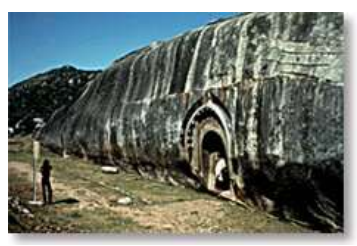
-
- Barabar Caves (4 caves): Karna Chaupar, Sudama Cave, Lamarshi (Lomas Rishi) Cave, Vishwamitra (Vishva Zopri) Cave
- Nagaragunja Caves (3 caves): In Bihar were formed during the time of Dasharath, grandson of Ashoka , Gopi Cave, Bahayak Cave and Vedantika Cave.
|
Ajivika Sect :
|
- Sculptures :
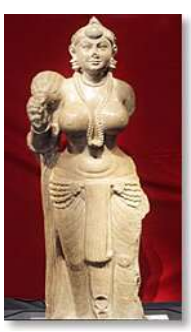
Two of the most famous sculptures of the Mauryan period are those of Yaksha and Yakshi. The Yakshini was worshiped as a religious symbol by the Mauryans.
-
- They were objects of worship related to all three religions – Jainism, Hinduism, and Buddhism.
- The earliest menƟon of yakshi can be found in Silappadikaram, a Tamil text.
- The torso of the nude male figure found at Lohanipur at Patna.
- Didargunj Yakshi was found at Didargunj village at Patna.
- The statue is a testament to the exceptional artistry and skill of Mauryan sculptors.
- It demonstrates their ability to create stunning and meaningful works of art.
- Rock-cut architecture: Ashoka was a significant patron of rock-cut architecture during his reign. He supported the creation of Mauryan Age Sculptures, primarily for Buddhists and Jain monks.

-
- These sculptures were carved out of rock.
- The interior walls of the caves were highly polished.
- The interior of the cave is rectangular, with a circular chamber at the back.
- The decorative gateways of the caves were remarkable.
- Example
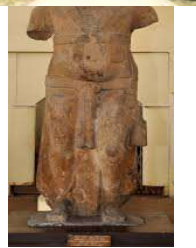
-
-
- Lomas Rishi Cave at the Barabar hills near Gaya The frontage of the cave exhibits a semicircular Chaitya arc. An elephant is carved in high relief on the chaitya. The interior hall of the cave is rectangular; it also has a circular chamber at the back. Ashoka patronised this cave for the Ajivika sect.
- Rock-cut elephant at Dhauli, Odisha – shows modelling in round with linear rhythm. It also has an Ashokan edict.
-
- Pottery: Pottery of the Mauryan era is generally referred to as Northern Black Polished Ware (NBPW). It has been primarily discovered in northern India.
- Mauryan pottery was characterized by black paint and highly lustrous finish and was generally used as luxury items.
- Kosambi and Patliputra were the significant centers of NBPW pottery.
- This type of pottery was widespread during the Mauryan period.
- It was used for various purposes, including storage, cooking, and serving.
- It provides valuable insights into the daily life and customs of the people of that period.
- Mauryan Terracottas: Terracotta art was widespread during the Mauryan period. Numerous terracotta figures and sculptures have been excavated from various sites.

-
- These sites include Bulandibagh, Patliputra, and Taxila.
- Among the discoveries was a sculpture of a dancing woman from Bulandibagh.
- Patliputra and Taxila also yielded additional terracotta representations.
- The style of Mauryan terracotta art exhibits the influence of Greek culture.
- The art form displays Greek-inspired features and techniques.
- Terracotta decorations, toys, and structures were popular subjects in Mauryan terracotta art.
- Mauryan Paintings
- Megasthenes indicates that the Mauryans possessed some fine paintings, but no examples have remained.
- The paintings of the Ajanta Caves, the earliest notable corpus of Indian art, reveal that there existed a well-developed tradition that may possibly date back to
Mauryan periods several years later.
Post Mauryan Art and Architecture :
With the decline of the Mauryan empire several small dynasties rose to power. Among them, Shungas, Kanvas, Kushanas and Shakas in the north and Satvahanas, Ikshavakus, Abhiras, and Vakatakas in Southern and Western India gained prominence.
- The architecture in the form of rock-cut caves and stupas continued, with each dynasty introducing some unique features of their own.
- Similarly, different schools of sculpture emerged and the art of sculpture reached its climax in the post-Mauryan period.
- Rock-cut Caves: The construction of rock caves continued as in the Mauryan period. However, this period saw the development of two types of rock caves – Chaitya and Viharas.
- Chaitya was a rectangular prayer hall with a stupa placed in the center, for the purpose of prayer and Viharas were used as the residences of the monks.
- Examples
- Udayagiri and Khandagiri Caves in Bhubaneshwar, Odisha were patronized by the Kalinga king Kharavela and are also known for the Hathigumpha inscription (in Brahmi script).
- Ranigumpha cave in Udayagiri is double-storied and has some beautiful sculptures.
- Udayagiri and Khandagiri Caves in Bhubaneshwar, Odisha were patronized by the Kalinga king Kharavela and are also known for the Hathigumpha inscription (in Brahmi script).
- Stupas: Post Mauryan period stupas became larger and more decorative and wood and brickwork were replaced by stone.

-
- Torans: In the post-Mauryan period, the Shunga dynasty introduced the idea of torans (Torans reflect the Hellenisti influence) which were beautifully decorated gateways to the stupas.
- Examples Bharhut stupa in Madhya Pradesh.
- Sculpture: Post Mauryan empire three prominent schools of the sculpture came into prominence in three different regions of India namely Gandhara, Mathura, and
Amravati schools.
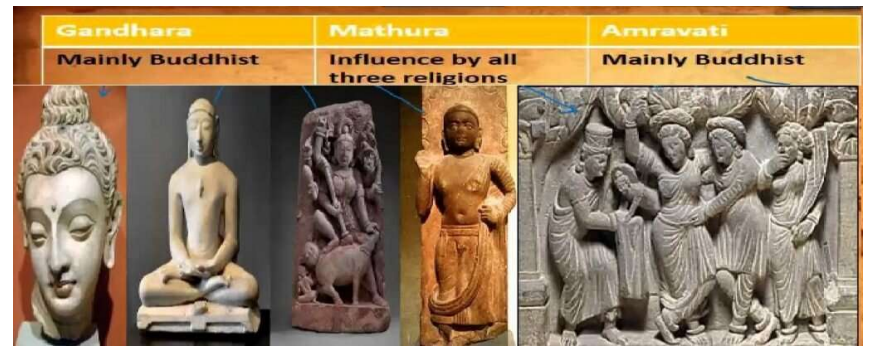
- Gandhara: The Gandhara School of Art or Greco-Indian School of Art (First sculptural representation of Buddha in human form) has its origin in Greco tradition (Greek invaders brought with them the traditions of the Greek and Roman sculptors) which was further merged with the regional or local art of the time.
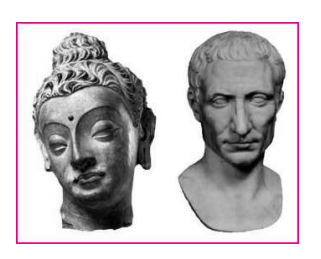
-
- Initial Development: Gandhara school was developed in the western frontiers of Punjab.
- Patronage: This school was patronized by both Shaka and Kushan rulers.
- Major centers of Gandhara school of art were Jalalabad (Eastern Afghanistan), Hadda (ancient region of Gandhara),Begram (Parwan province of Afghanistan) & Taxila (Pakistan).
- Key Features: Buddha was depicted in Gandhara Art, through four types of hand gestures called Mudras:
- Abahayamudra: Indicates fearlessness
- Dhyana mudra: Indicates meditative position
- Dharmachakramudra: Means turning the wheel of law.
- Bhumisparshamudra: Touching the earth with right hand and calling it to witness truth.
Mudras Related to Buddha of Gandhara School:
- Vitarka Mudra: It indicates teaching and discussion or intellectual debate.
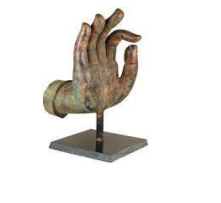
-
- The tips of the thumb and index finger touch each other, forming a circle.
- Anjali Mudra: Indicates greetings, devotion, and adoration.
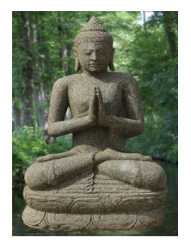
-
- Both hands close to the chest, palms, and fingers joined against each other vertically (Namaste posture).
- This is for Bodhisattvas (who aim and prepare to attain perfect knowledge).
- Uttarabodhi Mudra: It means supreme enlightenment.
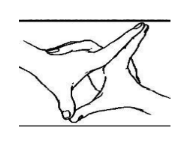
-
- This Mudra is known for charging one with energy. It symbolises perfection.
- Varada Mudra: It indicates charity, compassion or granting wishes.
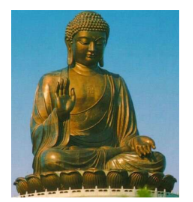
-
- Signifies five perfections: Generosity, morality, patience, effort and meditative concentration, through the five extended fingers.
- Karana Mudra: It indicates warding off evil.
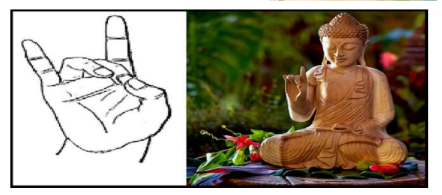
-
- The energy created by this Mudra helps remove obstacles such as sickness or negative thoughts.
- Vajra Mudra: It indicates knowledge.
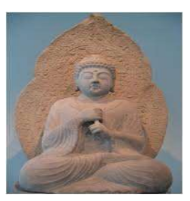
-
- This mudra signifies the importance of knowledge or supreme wisdom.
- Mathura: The sculptures of the Mathura school were influenced by all the three religions Buddhism, Hinduism, and Jainism.
- Initial Development: Developed in and around Mathura.
- Patronage: This school was patronized by Kushan rulers.
- Major Centres: Mathura, Sonkh and Kankalitila.
- Key Feature: Symbolism in the images was one of the key features of the Mathura school of art like Shiva was represented using linga and mukhalinga, Halo around the head of Buddha was decorated geometrical patterns and Buddha is shown to be surrounded by two Bodhisattavas Padmapani (holding a lotus) and Vajrapani (holding a thunderbolt).
- Amaravati: Unlike Gandhara and Mathura schools which focused on single images, Amaravati school laid more emphasis on the use of dynamic images or narrative art (like jataka tales).
- Initial Development: Amaravati school was developed on the banks of the Krishna river.
- Major Centres: Amaravati and Nagarjunakonda.
- Patronage: This school was patronized by Satvahana rulers.
- Key Feature: Tribhanga posture, i.e. the body with three bends was used excessively by Amaravati school in its sculptures.

Significance of Mauryan Art and Architecture
Mauryan Art and Architecture is significant in Indian history for several reasons:
- Mauryans made a remarkable contribution to art and architecture, and introduced stone masonry on a wide scale.
- Polished Stone Pillar: High technical skill was achieved by Maurya
artisans in polishing the stone pillars, which are as shining as the
Northern Black Polished Ware.
- The stone statue of Yakshini in the form of a beautiful woman
found in Didarganj (Patna) is noted for its Maurya polish.
- The stone statue of Yakshini in the form of a beautiful woman
- Pillars and Sculptor Development: Each pillar is made of a single piece of buff-colored sandstone. Only their capitals, which are beautiful pieces of sculpture in the form of lions or bulls, are joined to the pillars on the top.
- The erection of the polished pillars throughout India shows the spread of the technical knowledge involved in the art of polishing them.
- Development of Terracotta Art: In the central phase of the Northern Black Polished Ware around 300 BC, the central Gangetic plains became the center of terracotta art. In Mauryan rimes, terracotta were produced on a large scale.
- Mauryan pottery reflected the prosperity and power of the Mauryan Empire.
- Mauryan Art and Architecture was a fusion of different cultures including Indian, Persian, and Greek which turned out to be highly innovative.
- They exhibited a high degree of skill and craftsmanship.
- The Gupta period, in particular, was heavily influenced by Mauryan art and architecture.
- Rock-cut architecture during the Mauryan period was a significant achievement. It allowed for the creation of stunning structures, like the Great Stupa at Sanchi. Later, this form of cave architecture spread to western and southern India.
- Mauryan art and architecture promoted the spread of Buddhism.
- Many structures were built for religious purposes, like stupas and viharas. These structures served as important sites for religious practices. Religious ceremonies, teachings, and meditation were held at these sites.
- Mauryan art and architecture played an important role as the construction of public works improved the lives of people.
- The works included irrigation systems, roads, and infrastructure.
- They were commissioned by Mauryan rulers for administrative and economic purposes.
Mauryan Art and Architecture not only represented an artistic and architectural side of achievement but also contributed in shaping the cultural landscape of India.
Conclusion
Mauryan period saw the emergence of a unique architectural style. The style was characterized by the use of stone. It also featured the construction of massive structures. The art of the Mauryan period emphasizes realism and naturalistic motifs. Mauryan art is characterized by a fusion of different styles and techniques. The Ashoka Pillars are some of the best-known examples of Mauryan architecture.
Undoubtedly, Mauryan art and architecture reflect the political and cultural achievements of one of India's most powerful empires.
To conclude, the legacy of Mauryan art and architecture served as a catalyst for the evolution and enrichment of subsequent Indian artistic traditions, leaving an indelible imprint on the cultural, religious, and artistic heritage of the Indian subcontinent.

